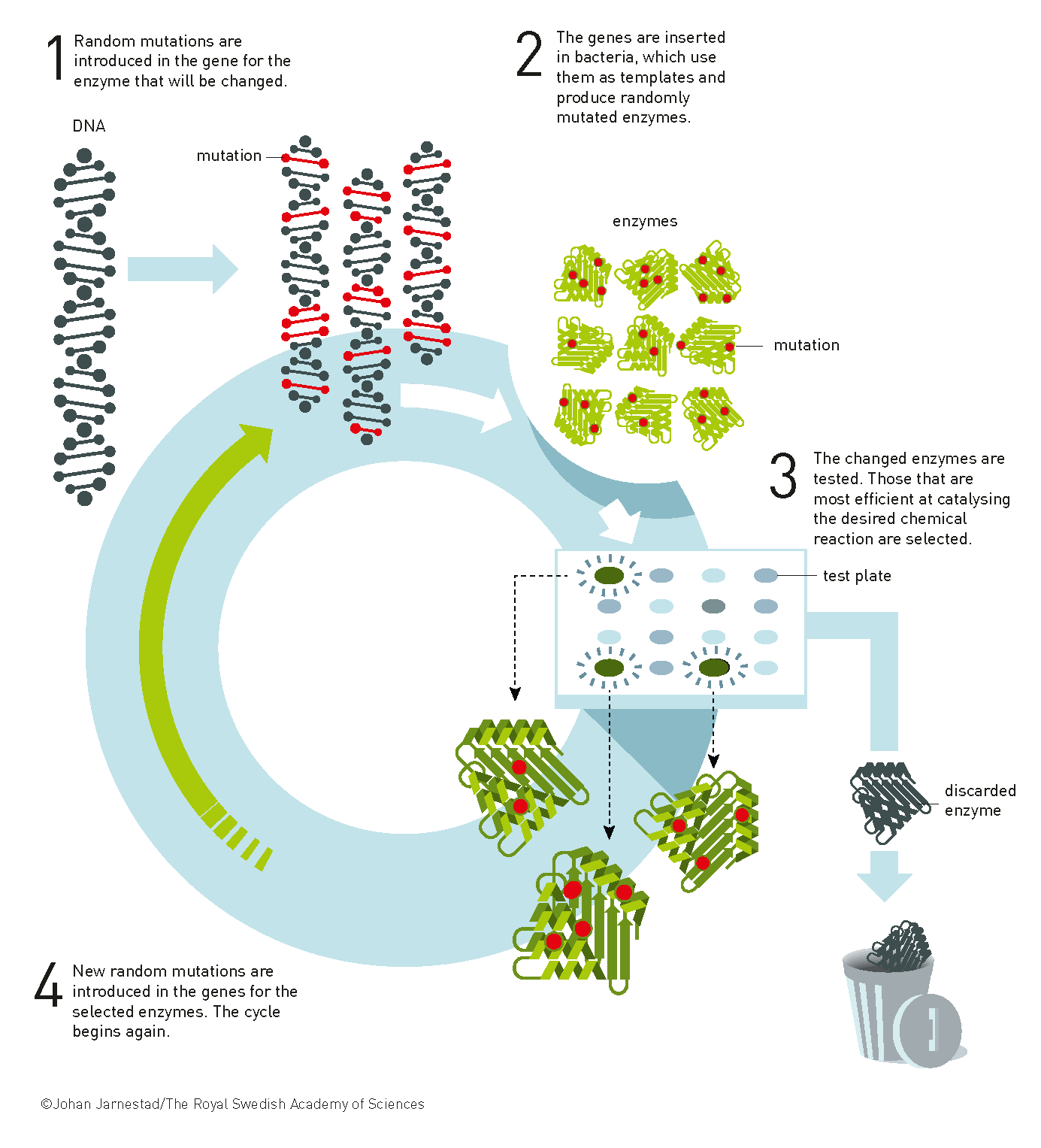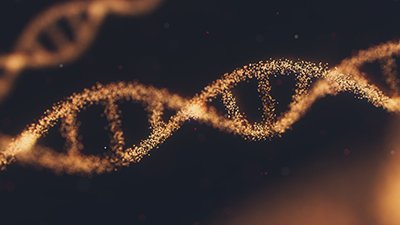Directed Evolution
In 2018 the Nobel Prize for physics was awarded to three researchers. Frances Arnold, from the California Institute of Technology, George Smith from the University of Missouri, and Gregory Winter of the University of Cambridge. All shared the Nobel Prize for their work in the field of directed evolution—Arnold for directed enzyme evolution and Smith and Winter for phage display.1
What Is Directed Evolution?
In theology circles, directed evolution is another term for theistic evolution, the (erroneous) belief that God used and still uses evolution to create and refine his creation.
In theology circles, directed evolution is another term for theistic evolution, the (erroneous) belief that God used and still uses evolution to create and refine his creation. But what is directed evolution in the scientific parlance? Directed evolution (hereafter called DE) is a method to design proteins (and enzymes) with desirable functions. The researcher generates random mutations in the gene of interest. Directed evolution is a form of artificial selection imposing selection and screening methodologies by the researcher to identify proteins with optimized functionality, including genetic diversity, binding, catalytic properties, thermal and environmental stability.2 In other words, the researcher’s intelligently designed goal is to get a protein or enzyme to do a new specific task, or to do one which it already does faster or more efficiently.
Directed Enzyme “Evolution”
In the case of Dr. Frances Arnold above, her contribution is described as directed enzyme evolution. Directed enzyme evolution starts off with an enzyme that has the desired properties (in the initial case, Arnold was looking for an enzyme that cleaves peptide bonds in organic solvents). Then Arnold introduced random mutagenic changes into the genes. Different versions of the mutated gene were then inserted into bacteria and Arnold looked for bacteria which showed some increased functionality, such as faster performance in breaking down sugars or the ability to operate under conditions it fared poorly in before. Arnold then chose the bacteria whose enzymes worked best in organic solvents and subjected them to further rounds of artificial selection. The end result was an enzyme that worked 256 times better in organic solvents than the original type. Recently, her lab has developed mutant strains of E. coli, which converts sugar into isobutanol, which may be useful in developing biofuels or biodegradable plastics. Her lab has also modified lipases (an enzyme that speeds up the breakdown of fats to fatty acids and glycerol or other alcohols) which have proved effective at removing stains from clothing in cold water.3

Free-use image derived from https://www.nobelprize.org/uploads/2018/10/press-fig2-enzymeEvolution.pdf
Figure 1
Phage Display
Dr. George Smith is credited with the discovery of the phage display methodology in 1985. Phage display involves the insertion of a gene into the part of a bacteriophage’s (a virus that infects bacteria) genome that contains the blueprint for its protein coat. When the phage replicates, the protein the inserted gene encodes for ends up in the subsequent bacteriophage’s coat.

Free-use image derived from https://www.nobelprize.org/uploads/2018/10/press-fig3-phageDisplay.pdf
Figure 2
In 1990, Dr. Gregory Winter took Dr. Smith’s idea further and started using phages to make antibodies. He inserted genes for antibodies into phages, which promptly inserted these Y-shaped proteins into their coats when they replicated. Antibodies can stick to bacteria and viruses, signaling to host immune cells to destroy these foreign invaders. The phage display methodology relies on the production of a vast library of bacteriophages that have been genetically engineered to display different peptides or proteins on their surface. The phages are refined and improved for specific target efficiency by a process called biopanning.
Phages whose antibodies don’t stick well to this target get removed during a purification step [biopanning]. Those that perform well are subjected to a round of random mutation and the search for the antibodies that stick best to the disease target is repeated. Repeating this cycle a few times creates antibodies that strongly bind to their target and, in theory, could be used as a drug.4

Free-use image derived from https://www.nobelprize.org/uploads/2018/10/press-fig4-antibodyEvolution.pdf
Figure 3
Dr. Winter had as a long-term goal that these phage-produced antibodies be used in pharmaceutical research, with an eye on developing new drugs. In 2002, the first phage display drug (Humira) was approved. Humira (adalimumab) neutralizes an inflammation protein in diseases such as rheumatoid arthritis and inflammatory bowel diseases (e.g. ulcerative colitis and Crohn’s disease). It is now the world’s biggest selling drug and had sales of $16 billion in 2016.5
Is Directed Evolution Really “Evolution”?
Developing new methodologies for producing biofuels, making better organic solvents, and (especially) treating and/or curing diseases are worthy achievements and are to be celebrated. But in the press release mentioning their Nobel award, everything is described as “evolution” Phrases like “have taken control of evolution,” “they harnessed the power of evolution,” and “inspired by the power of evolution and used the same principles” are scattered throughout.6 If you really think about it, doesn’t it seem insulting to tell a Nobel Prize winner that all their hard work, thought processes, and dedication are akin to a mindless, purposeless, random, and “prone to fail more often that in succeeds” process like evolution? Wouldn’t it be far better to ascribe their efforts to a God-given intellect?
Are intelligently designed experiments, done in state-of-the-art facilities, using (and modifying) already present features in already-existing bacteria and viruses really examples of molecules-to-man evolution? No!
But are intelligently designed experiments, done in state-of-the-art facilities, using (and modifying) already-present features in already-existing bacteria and viruses really examples of molecules-to-man evolution? No! These are examples of directed mutation and selection, to be sure, but no new information was generated. It was merely tweaked by a guiding human intelligence.
Harnessing viruses to produce beneficial outcomes and manipulating bacteria to increase process efficiency or make them more target specific are wonderful examples of intelligent design. Since God has given mankind dominion over his creation (Genesis 1:28), it is only fitting that we should seek to wisely steward our resources and to treat diseases. These things can (and should) bring glory to God, who gave humans the intelligence to do these things. But to ascribe them to “evolution” is both untrue and unwise. Rather we should follow the example of David, acknowledging the majesty of the God who has given mankind these abilities.
What is man that you are mindful of him, and the son of man that you care for him? Yet you have made him a little lower than the heavenly beings and crowned him with glory and honor. You have given him dominion over the works of your hands; you have put all things under his feet, all sheep and oxen, and also the beasts of the field, the birds of the heavens, and the fish of the sea, whatever passes along the paths of the seas. O LORD, our Lord, how majestic is your name in all the earth! (Psalm 8:4–9)
Footnotes
- The Nobel Prize, “The Nobel Prize in Chemistry 2018,” Last Accessed January 28, 2020, https://www.nobelprize.org/prizes/chemistry/2018/summary/.
- For the evolutionary definition, see: J.D. Bloom, and F.H. Arnold, “In the light of directed evolution: pathways of adaptive protein evolution,” Proceedings of the National Academy of Sciences, 106 (Supplement 1, 2009): 9995.
- Natalie Angier, “Frances Arnold Turns Microbes Into Living Factories,” The New York Times, May 28, 2019, https://www.nytimes.com/2019/05/28/science/frances-arnold-caltech-evolution.html.
- Katrina Krämer, “What is directed evolution and why did it win the chemistry Nobel prize?,” Chemistry World, October 3, 2018, https://www.chemistryworld.com/news/what-is-directed-evolution-and-why-did-it-win-the-chemistry-nobel-prize/3009584.article#/.
- Ibid.
- Press release: The Nobel Prize in Chemistry 2018, NobelPrize.org, Accessed January 30, 2020, https://www.nobelprize.org/prizes/chemistry/2018/press-release/.
Recommended Resources

Answers in Genesis is an apologetics ministry, dedicated to helping Christians defend their faith and proclaim the good news of Jesus Christ.
- Customer Service 800.778.3390
- Available Monday–Friday | 9 AM–5 PM ET
- © 2026 Answers in Genesis





